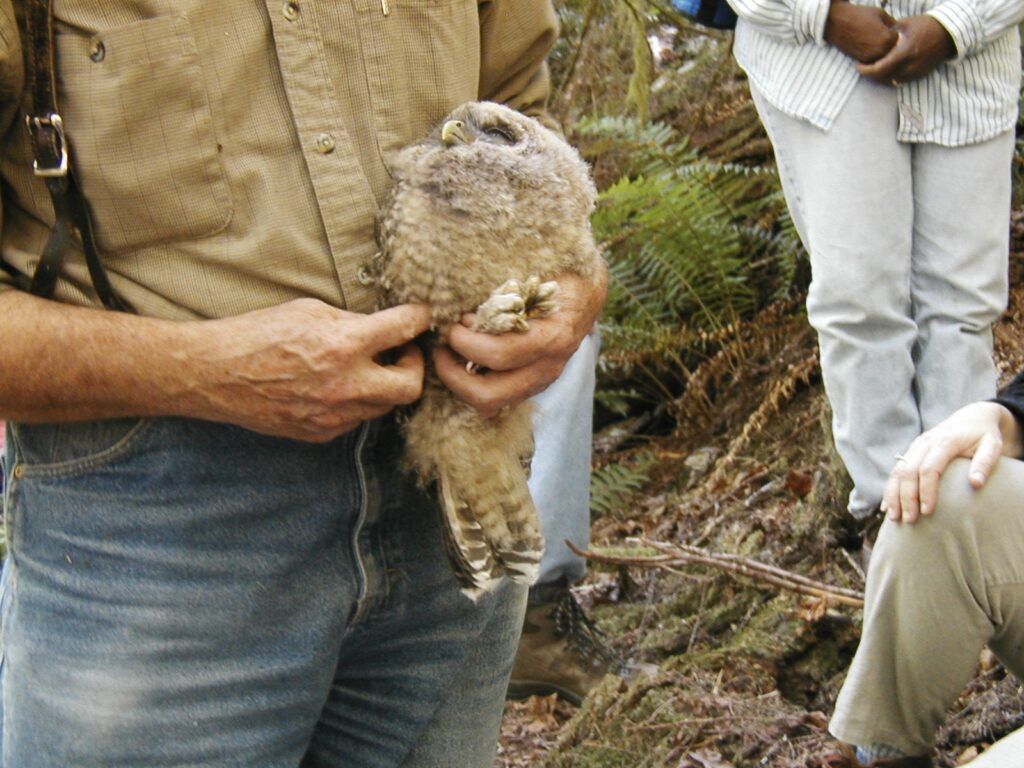Species protections lag behind climate-driven declines
By Chad Small | November 3, 2023
 The Northern spotted owl was listed as “threatened” under the Endangered Species Act in 1990 due to habitat loss, but has continued to see its population continue to decline directly and indirectly due to climate change. (Photo: USFWS)
The Northern spotted owl was listed as “threatened” under the Endangered Species Act in 1990 due to habitat loss, but has continued to see its population continue to decline directly and indirectly due to climate change. (Photo: USFWS)
If you type “species worth protecting” into Google, the top image results will show pictures of panda bears, polar bears, rhinoceroses, or even bald eagles. No matter how long you scroll, it’s unlikely that a picture of lady bugs will come up. What the first group has in common—in addition to being charismatic megafauna—is that all those animals have been or are endangered. Lady bug species may not be endangered, but their numbers are falling.
Species currently categorized as “endangered” or “threatened” receive the bulk of conservation efforts and funding. Much less attention is given to species who are deemed “non-threatened” but are currently in population downturn. While over a quarter of species are classified as “endangered” or “threatened,” almost half of all species are experiencing some degree of population decline. This has led to growing concern among ecologists that a species’ population growth or decline is better indicator of its risk for extinction than baseline categorizations like “endangered” or “non-threatened.” Ignoring how a species is trending might miss how factors like climate change rapidly affect ecological outlooks.
The primary arbiter for at-risk species is The International Union for Conservation of Nature (IUCN) Red List of Threatened Species. The Red List categorizes species as “endangered,” “critically endangered,” or “threatened” based on information like how many members of species exist, and how extensive their geographical range might be. These determinations are made based on static metrics—snapshots of how robust a population is at a particular time—and are the primary basis for the most powerful (and successful) conservation law ever created: The Endangered Species Act.
“Over 99 percent of species protected under [The Endangered Species Act] have avoided extinction,” says Patrick Donnelly, the Great Basin Director for the Center for Biological Diversity. “Now I want you to go find any government program or law that has a 99 percent success rate.”
Enacted in 1973, the law empowers the United States Fish and Wildlife Service and the National Marine Fisheries Service to protect species endangered or threatened by economic growth and development. This can take the form of protecting critical habitats, limiting hunting, or even banning the importation of certain animal derived products. As effective as the law has been, it isn’t foolproof. On the eve of the Act’s 50th birthday last month, the Fish and Wildlife Service delisted 21 species due to extinction. In a press release, the agency stated that “the 21 species extinctions highlight the importance of the [Endangered Species Act] and efforts to conserve species before declines become irreversible.”

For the Endangered Species Act (and its contemporaries abroad) to start conservation actions, a species needs to be listed as “endangered” or “threatened.” The IUCN Red List has designated 28 percent of all species (a startling 41,200 of them) at critical risk of extinction. But even that dire figure doesn’t capture the full picture.
Researchers out of Queen’s University Belfast have found that these conventional listing and conservation practices might be missing warning signs that species currently not endangered might be rapidly trending downward.
“Almost half of animals on Earth for which assessments are available are currently declining,” Catherine Finn, one of those researchers from Queen’s University Belfast, has explained. “To make matters worse, many of the animal species that are thought to be non-threatened from extinction are in fact progressively declining.”
This means species which might be declining but are unlisted exist without any formal protective measures.
These declines span all types of animals and insects. Whether it is the 63 percent of amphibians (over 3,100 species) declining, or the 53 percent of birds (over 5,400), population downturns are incredibly widespread. In the case of birds, in particular, the IUCN categorizes only about 13 percent of bird species as threatened, endangered, or extinct. But over half of all bird species are currently declining.
The northern spotted owl lives along the North American West Coast, from San Francisco to Vancouver, British Columbia. This bird is a popular species among birdwatchers and naturalists. The owl is very used to humans, making it a frequent, but welcome sight for hikers—even those who only enjoy short hikes instead of long adventures. It’s also been listed as a “threatened” species under the Endangered Species Act since 1990.
Although the Endangered Species Act has historically been effective, the northern spotted owl is not doing as well as one might expect. According to Meagan Carmack, a graduate researcher at the University of Washington (and a colleague of mine), the northern spotted owl is seeing its population continue to decline directly and indirectly due to climate change.
“The spotted owls are not particularly resilient to heat shocks, and there have been some recorded deaths from heat waves in 2021,” she says.
Heat waves along the West Coast, like the 2021 Pacific Northwest Heat Dome, are likely becoming more frequent due to climate change. These heat waves will push the northern spotted owl further into population decline despite its listing status, Carmack argues. Additionally, climate change’s influence on invasive species might also be contributing to the woes of the northern spotted owl.
The barred owl, a native of the Southeastern United States, has encroached more and more into the territory of the northern spotted owl causing even more population decline.
“[Barred owls] are very territorial and are much larger than the spotted owls,” Carmack explains. “In direct head-to-head confrontations, spotted owls are not going to win.”
This has led to barred owls pushing northern spotted owls out of their breeding grounds. A combination of heat stress and crashing reproduction rates has driven down the northern spotted owl population much faster than would otherwise be expected. Carmack highlights that this kind of decline has not been well accounted for in conservation listing practices or protection activities like the IUCN Red List or the Endangered Species Act.
Species can sometimes respond rapidly to climate change, but the changes can also be slow and progressive. If you look at species’ wellbeing only through a population snapshot, you might miss a species gradually deteriorating—until the losses really start piling up. This is what has been happening to the northern spotted owl. Static listing practices initially missed its steady population decline until researchers like Carmack started to pick up on them.
The gaps in conservation listing practices and conservation laws could provide an opportunity to update or improve these practices. Listing standards could incorporate a dynamic approach that tracks how populations are growing or shrinking. This could empower conservation policies domestically and abroad to deploy resources for species protection before reaching “threatened” or “endangered” thresholds.
“Once a species is critically endangered, it’s difficult to save,” Colin Chapman, a biologist at Canada’s Vancouver Island University, told MongaBay. “So we should be a lot more worried about species that are not listed by IUCN that may need special attention.”
Improving and expanding the powers of the Endangered Species Act in the United States’ current political climate seems an impossibly tall order, since the agencies responsible for enforcing it are already underfunded and understaffed in executing the Act as it is. Funding allocated through the Endangered Species Act is used not just to fund conservation efforts, but also evaluate species waiting to be listed.
“There are hundreds of species that are waiting to have their listing status evaluated,” Donnelly says. “The [Fish and Wildlife Service] just hasn’t gotten to it yet because they’re underfunded.”
Species waiting to be listed are stuck without conservation funding at all. Even for species listed, the amount of funding isn’t equally distributed. “You hear a lot about grizzly bears and wolves, and we spend millions and millions of dollars on their conservation,” Donnelly says. “There are hundreds and hundreds of species of plants and animals, rare ones, that receive less than a thousand dollars’ worth of conservation investment.”
Additionally, Republican lawmakers have been pushing to pull certain species off the endangered species list because their protection interferes with economic development. In September, President Biden vetoed a Republican-sponsored bill that would have taken the lesser prairie chicken and northern long-eared bat off the endangered species list.
Pete Stauber, a Republican congressman from Minnesota, said that the conservation of the long-eared bat was “being used to stifle development rather than its intended purpose, which is to protect species from human-caused harm.”
In March, 120 conservation groups urged Congress to more than double the Fish and Wildlife Service’s conservation budget. Stephanie Kurose, senior endangered species policy specialist at the Center for Biological Diversity, said “there’s no better way to honor this landmark law and its five decades of success than by fully funding it.”
Fully funding the Endangered Species Act would be funding the law to operate as it always has. It wouldn’t necessarily incorporate potentially necessary changes in how it tracks species loss. And there seems to be little political bandwidth for incorporating more dynamic listing practices that would protect more species.
The Endangered Species Act has saved almost 300 species from extinction, and maintaining its effectiveness is instrumental to both domestic and international animal conservation. It will, however, have to contend with very active climate change impacts that have intensified since it was signed into law.
“All wildlife is threatened by climate change,” Donnelly says. “I don’t think listed species are any more threatened than non-listed species.”
Together, we make the world safer.
The Bulletin elevates expert voices above the noise. But as an independent nonprofit organization, our operations depend on the support of readers like you. Help us continue to deliver quality journalism that holds leaders accountable. Your support of our work at any level is important. In return, we promise our coverage will be understandable, influential, vigilant, solution-oriented, and fair-minded. Together we can make a difference.
Keywords: Endangered Species Act, climate crisis, endangered species, invasive species
Topics: Climate Change














